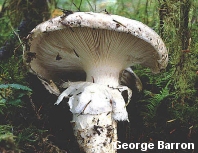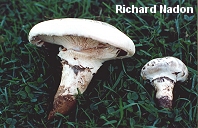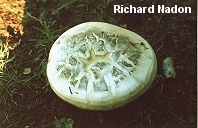| Major Groups > Gilled Mushrooms > Pale-Spored > Catathelasma > Catathelasma ventricosum |

|
Catathelasma ventricosum [ Basidiomycetes > Agaricales > Tricholomataceae > Catathelasma . . . ] by Michael Kuo This species, also known as "Catathelasma ventricosa," is well characterized by northeastern North American collections. It grows under conifers and features a whitish cap that develops grayish fibrils and spots. Its gills run down the stem, and it sports a large, flaring, double ring on its stem. Its odor and taste are mild or slightly unpleasant, but not mealy. Things get complicated as one moves westward, however, and authors begin to shift the concept of Catathelasma ventricosum to include collections with browner caps and mealy odors, introducing the potential for confusion with Catathelasma imperiale. Western authors have struggled with a means to separate the two species, resorting to the size of the cap, spore size, and other microscopic features. The cap and spores of Catathelasma imperiale are, theoretically, a little larger--but the overlap in size ranges is substantial. Since DNA studies have yet to focus on Catathelasma (to my knowledge), and since we are likely to discover once they do that we are not even playing in the right ballpark, features-wise, I am content to stick with the whitish cap and the not-mealy odor as defining features for Catathelasma ventricosum--for now. Whether or not this leaves any room for Catathelasma ventricosum in the Rocky Mountains and westward is dubious, but if western collectors are frustrated with me they can take solace in the fact that I have limited Catathelasma imperiale to the West, despite the insistence of some eastern authors that it occurs east of the Rockies. Description: Ecology: Presumably mycorrhizal; growing alone or scattered on the ground under conifers; fall; northeastern North America (but reported from the Rocky Mountains and the West Coast; see above). Cap: 8-30 (or more) cm; convex becoming irregularly convex or nearly flat; dry; smooth or in maturity with scattered pressed-down fibers; whitish, developing grayish areas; the margin at first rolled under somewhat. Gills: Running down the stem or beginning to do so; close; whitish. Stem: Up to 15 cm long and 5 cm wide; often swollen in the middle; tapering at the base and usually rooting somewhat; sometimes almost completely underground; whitish, discoloring brownish or grayish; with a flaring, double ring. Flesh: White; hard; not changing on exposure. Odor and Taste: Taste not distinctive or slightly unpleasant; odor similar. Spore Print: White. Microscopic Features: Spores 9-13 x 4-6 µ; smooth; elongated-elliptical; amyloid. Basidia under 45 µ long. REFERENCES: (Peck, 1896) Singer, 1940. (Saccardo, 1899; Saccardo, 1912; Singer, 1978; Smith, Smith & Weber, 1979; Phillips, 1991/2005; Lincoff, 1992; Evenson, 1997; Barron, 1999; McNeil, 2006; Miller & Miller, 2006; Kuo, 2007.) This site contains no information about the edibility or toxicity of mushrooms. |
© MushroomExpert.Com |
|
Cite this page as: Kuo, M. (2006, October). Catathelasma ventricosum. Retrieved from the MushroomExpert.Com Web site: http://www.mushroomexpert.com/catathelasma_ventricosum.html |


